
If you’ve ever conducted business, read a financial report, or even seen a movie budget from the Indian subcontinent, you’ve likely come across the terms Lakh and Crore. For those accustomed to the Western system of thousands, millions, and billions, this can be a source of confusion.
While the numbers themselves are the same, the Indian numbering system uses a different grouping structure. Understanding these terms is essential for clear communication and accurate financial dealings in this part of the world.
The Key Difference: How Commas are Placed
The most noticeable difference between the Western and Indian systems is how commas are used to group numbers. This simple rule is the key to understanding the entire system.
- In the Western system, commas are placed every three digits from the right to denote thousands, millions, etc. (e.g., 1,000,000).
- In the Indian system, the first comma is placed after three digits (for thousands), but all subsequent commas are placed after every two digits to mark the Lakhs and Crores.
| Western System (Figures) |
Western System (Words) |
Indian System (Figures) |
Indian System (Words) |
|---|---|---|---|
| 100,000 | One Hundred Thousand | 1,00,000 | One Lakh |
| 1,000,000 | One Million | 10,00,000 | Ten Lakhs |
| 10,000,000 | Ten Million | 1,00,00,000 | One Crore |
| 1,000,000,000 | One Billion | 1,00,00,00,000 | One Hundred Crores |
What Are Lakhs and Crores?
This unique comma placement corresponds directly to the two core units of the Indian numbering system.
- Lakh (or Lac): The two digits before the first comma (from the left) represent Lakhs. A Lakh is a unit equal to one hundred thousand (100,000).
For example, a car costing ₹8 Lakh means its price is ₹8,00,000 (or 800,000 rupees).
- Crore: The digits before the second comma (from the left) represent Crores. A Crore is a unit equal to ten million (10,000,000). It is also equivalent to 100 Lakhs. Large figures like a company’s revenue or the price of a property are often stated in Crores.
For instance, a property worth ₹2 Crore is priced at ₹2,00,00,000 (or 20,000,000 rupees).
Navigating Conversions with Confidence
Understanding these conversions is crucial for anyone working with data or documents from India.
- To convert Million to Lakhs, simply multiply by 10. (e.g., 5 million = 50 lakhs)
- To convert Crores to Millions, simply multiply by 10. (e.g., 3 crores = 30 million)
While the system may seem different at first, it’s a logical and widely used method. The key is to remember the values of Lakh and Crore and to pay close attention to the comma placement.
In a world of global business, precision in numbers is paramount. Instead of manually converting or guessing, an accurate online converter is an indispensable tool. It takes the guesswork out of these regional variations, providing the correct and consistent word format every time.